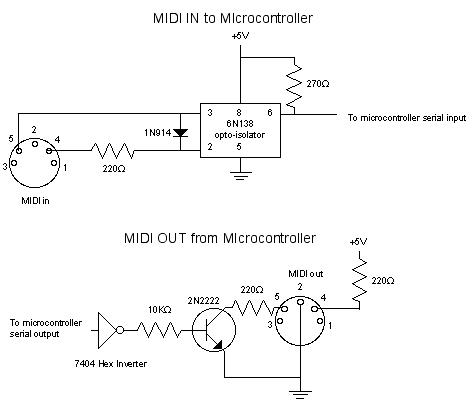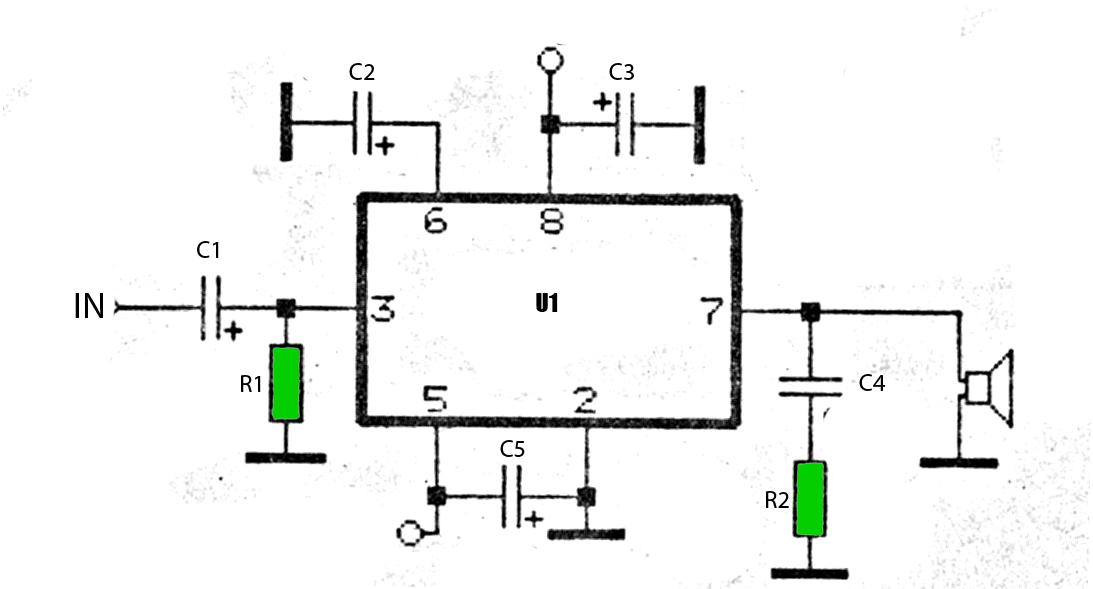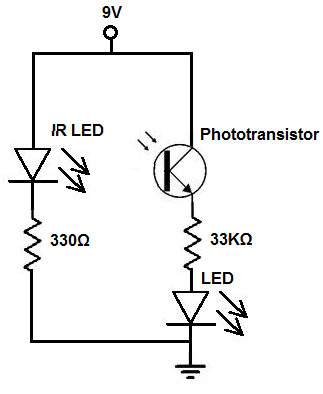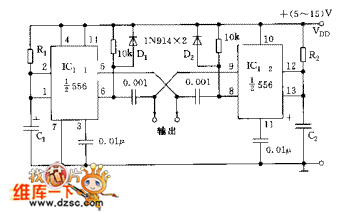
LM35 Digital Remote Thermometer circuit and explanation
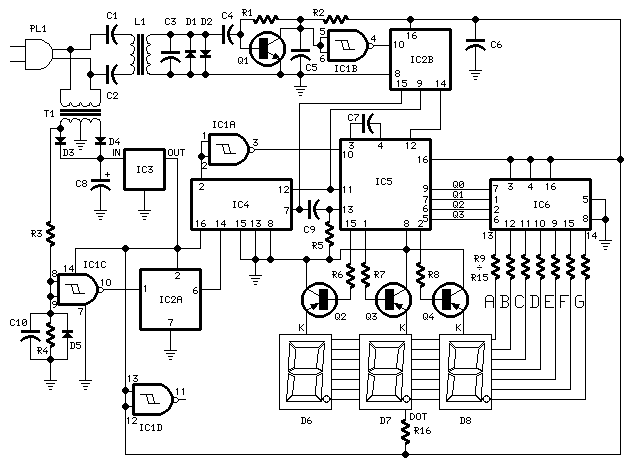
The receiver circuit and display module will receive the high-frequency AC power cord and decode it to provide actual temperature readings using digital IC No. CD4553 (Three-digit BCD Counter IC) and IC CD4511 (BCD-to-7-Segment Latch/Decoder/Driver IC). The frequency pulses from the wall are safely isolated by capacitors C1, C2, and inductor L1, then amplified by transistor Q1. Diodes D1 and D2 limit the peak admission of the signal. The pulses are filtered by capacitor C5, and IC1b squares the signal, which is then divided by 10 in IC2B before being sent to the final countdown clock input of IC5. IC4 acts as the time base generator, providing reset pulses to IC1b and controlling the locking and opening time of IC5 at a frequency of 1Hz. It is powered by a 5Hz square wave obtained from the 50Hz mains frequency, which is retrieved from the secondary of transformer T1, squared, and divided by 10 in IC1C and IC2A. IC5 reads across the cathodes of transistors Q2, Q3, and Q4 at a rate determined by frequency multiplexing with capacitor C7. The readings are displayed on three anodes in parallel through the BCD to 7-segment decoder IC6. In summary, an input pulse power of, for example, 2kHz frequency is divided by 10 and displayed as 20.0 °C.
The described circuit functions as a temperature measurement and display system that utilizes digital electronics for precise readings. The high-frequency AC signal is first isolated to prevent any potential damage to sensitive components. The use of capacitors and inductors ensures that only the desired frequency range is amplified, while diodes serve to protect against voltage spikes.
The digital counting and decoding process is facilitated by the integration of the CD4553 and CD4511 ICs. The CD4553 serves as a BCD counter, which counts the incoming pulses and converts them into a binary-coded decimal format. The CD4511 then translates this BCD output into a format suitable for display on a 7-segment display, allowing for easy reading of temperature values.
The filtering stage, using capacitor C5, ensures that the signal is clean and free from noise, which is critical for accurate measurements. The time base generator (IC4) is essential for creating a stable timing reference, enabling consistent operation of the entire circuit. The division of the frequency signal allows for scaling the input frequency down to a more manageable level for temperature representation.
The final output is displayed through multiplexing techniques, where the three anodes are activated in sequence, ensuring that the display is dynamic and can show the required temperature readings effectively. This multiplexing is controlled by the frequency determined by the previously mentioned components, ensuring that the display updates at a rate that is visually perceptible to the user.
Overall, this circuit design exemplifies a robust method for converting high-frequency AC signals into readable temperature data, demonstrating the integration of various electronic components to achieve a specific measurement goal.For the receiver circuit and display modulewill receive the high frequency AC power cordand decode out to be the actual temperature figures with digital IC No. CD4553 Three-digit BCD Counter IC) and IC-CD4511 (BCD-to-7-Segment Latch / Decoder / Driver IC). The frequency pulses from the wall and safely isolated by C1, C2 and L1 are amplified by Q1 , diodes D1 and D2 of the peak limit his admission. The pulses are filtered by C5, IC1b square, divided by 10 in IC2B and sent for final countdown clock input of IC5. IC4 is the time base generator: it provides IC1b and reset pulses to the making and IC5 locks and opening time of IC5 at 1Hz frequency.
It is powered by a 5Hz square wave obtained from the frequency 50Hz sector Retrieved from T1 secondary, squared and divided by 10 in IC1C IC2A. IC5 readers across the cathodes scenes Q2, Q3 and Q4 with a rate determined by frequency multiplexing C7.
Readers also shows three anodes in parallel by the BCD to 7 segments decoder IC6. In summary, the input pulse power on, say, 2kHz frequency be divided by 10 and displayed as 20. 0 ° C 🔗 External reference
The described circuit functions as a temperature measurement and display system that utilizes digital electronics for precise readings. The high-frequency AC signal is first isolated to prevent any potential damage to sensitive components. The use of capacitors and inductors ensures that only the desired frequency range is amplified, while diodes serve to protect against voltage spikes.
The digital counting and decoding process is facilitated by the integration of the CD4553 and CD4511 ICs. The CD4553 serves as a BCD counter, which counts the incoming pulses and converts them into a binary-coded decimal format. The CD4511 then translates this BCD output into a format suitable for display on a 7-segment display, allowing for easy reading of temperature values.
The filtering stage, using capacitor C5, ensures that the signal is clean and free from noise, which is critical for accurate measurements. The time base generator (IC4) is essential for creating a stable timing reference, enabling consistent operation of the entire circuit. The division of the frequency signal allows for scaling the input frequency down to a more manageable level for temperature representation.
The final output is displayed through multiplexing techniques, where the three anodes are activated in sequence, ensuring that the display is dynamic and can show the required temperature readings effectively. This multiplexing is controlled by the frequency determined by the previously mentioned components, ensuring that the display updates at a rate that is visually perceptible to the user.
Overall, this circuit design exemplifies a robust method for converting high-frequency AC signals into readable temperature data, demonstrating the integration of various electronic components to achieve a specific measurement goal.For the receiver circuit and display modulewill receive the high frequency AC power cordand decode out to be the actual temperature figures with digital IC No. CD4553 Three-digit BCD Counter IC) and IC-CD4511 (BCD-to-7-Segment Latch / Decoder / Driver IC). The frequency pulses from the wall and safely isolated by C1, C2 and L1 are amplified by Q1 , diodes D1 and D2 of the peak limit his admission. The pulses are filtered by C5, IC1b square, divided by 10 in IC2B and sent for final countdown clock input of IC5. IC4 is the time base generator: it provides IC1b and reset pulses to the making and IC5 locks and opening time of IC5 at 1Hz frequency.
It is powered by a 5Hz square wave obtained from the frequency 50Hz sector Retrieved from T1 secondary, squared and divided by 10 in IC1C IC2A. IC5 readers across the cathodes scenes Q2, Q3 and Q4 with a rate determined by frequency multiplexing C7.
Readers also shows three anodes in parallel by the BCD to 7 segments decoder IC6. In summary, the input pulse power on, say, 2kHz frequency be divided by 10 and displayed as 20. 0 ° C 🔗 External reference
